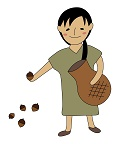SASAKI Yuka
Education
1997–1999 Showa Women’s University, M.A., Arts.
1999–2001 Showa Women’s University, D.C., Arts.
2012 Obtained degree of Dr. Env. from Tokyo University.
1999–2001 Showa Women’s University, D.C., Arts.
2012 Obtained degree of Dr. Env. from Tokyo University.
Employment
2019 – present, Visiting Researcher, Center for Obsidian and Lithic Studies, Meiji University
2020 - 2021, Project Researcher, The University Museum, The University of Tokyo
2021-present, Associate Professor, Institute for the Study of Ancient Civilizations and Cultural Resources Kanazawa university
2020 - 2021, Project Researcher, The University Museum, The University of Tokyo
2021-present, Associate Professor, Institute for the Study of Ancient Civilizations and Cultural Resources Kanazawa university
Current Research
■Study of prehistoric use of plant resources.
■Prehistoric technique of basketry and basket materials in Japan.
■Plant domestication in prehistoric Japan.
■Prehistoric technique of basketry and basket materials in Japan.
■Plant domestication in prehistoric Japan.
Honors
■2007 Fifth Incentive Award, the Japanese Association of Historical Botany
■2014 Youth Presentation Award, The Japan Association for Quaternary Research (JAQUA)
■2014 Youth Presentation Award, The Japan Association for Quaternary Research (JAQUA)
Academic Fellowship and Activities
■Council member of the Japanese Association of Historical Botany, 2017–present.
■Council member of the Japanese Society for Scientific Studies on Cultural Properties, 2018–present.
■Council member of the Japanese Society for Scientific Studies on Cultural Properties, 2018–present.
Selected Publications
Selected Monographs and Articles
| 2022 | Юка Сасаки, Сауле Жангельдыевна Рахимжанова, Ақан Оңғар, Архат Мирхатович Каирмагамбетов, Эйко Эндо, Паула Доумани Дюпюй, МадинаМакулбекова, Роберт Шпенглер, Шинья Шода Отпечатки проса на керамике раннего железного века из кургана Тортоба в Западном Казахстане. Археология Казахстана.4 (18), 116-132. |
| 2021 | Noshiro S., Sasaki Y., Murakami Y. Importance of Quercus gilva (イチイガシ) for the prehistoric periods in western Japan.Japanese Journal of Archaeology 8-2, 33-156. |
| 2019 |
Kazuki Morisaki, Noriyoshi Oda, Dai Kunikita, Yuka Sasaki, Yasuko Kuronuma, Akira Iwase, Takeshi Yamazaki, Naoichiro Ichida, Hiroyuki Sato Sedentism, pottery and inland fishing in Late Glacial Japan: a reassessment of the Maedakochi site. Antiquity, 93-372, 1442-1459. |
| Noshiro, S., Sasaki, Y., Kobayashi, K., Suzuki, M., Nishida, I. Material selection and weaving techniques for the oldest basketry in Japan found at the Higashimyou site, Saga Prefecture. Journal of Archaeological Science: Reports 23: 12–24. | |
| 2018 | Sasaki, Y., Noshiro, S. Did a cooling event in the middle to late Jomon periods induced change in the use of plant resources in Japan? Quaternary International 471: 369–384. |
| 2016 | Noshiro, S., Kudo, Y., Sasaki, Y. Emergence of prehistoric management of plant resources during the incipient to initial Jomon periods in Japan. Quaternary International 426: 175–186. |
| Noshiro, S., Sasaki, Y. Pre-agricultural management of plant resources during the Jomon period in Japan—A sophisticated subsistence system on plant resources. Journal of Archaeological Science 42: 93–106. | |
| 2011 | Noshiro, S., Sasaki, Y. Identification of Japanese species of evergreen Quercus and Lithocarpus (Fagaceae). IAWA Journal 32: 383–393. |
| Lee, Gyoung-Ah, G. W. Crawford, Li Liu, Xingcan Chen, Yuka Sasaki, Xuexiang Chen. Archaeological soybean (Glycine max) in East Asia: Does size matter? PLos One, 6(11), e26720 | |
| 2009 | Noshiro, S., Sasaki, Y., Suzuki, M. How natural are natural woods from wetland sites? – a case study at two sites of the Jomon period in central Japan. Journal of Archaeological Science 36: 1597–1607. |
| 2007 | Noshiro, S., Suzuki, M. & Sasaki, Y. Importance of Rhus verniciflua Stokes (lacquer tree) in prehistoric periods in Japan, deduced from identification of its fossil woods. Vegetation History and Archaeobotany 16: 405–411. |
Presentations at the International Congress and Workshop
2023 |
Eiko Endo, Yuka Sasaki. Seed Impressions in Ceramics. Novel SEM Approaches for Archaeological Artifact Analysis. 16 Mar. 2023, Nazarbayev Umiversity, Kazakhstan. |
| Paula Dupuy, Yuka Sasaki. Textile Impressions in Ceramics. Novel SEM Approaches for Archaeological Artifact Analysis. 16 Mar. 2023, Nazarbayev Umiversity, Kazakhstan. | |
2022 |
Yuka Sasaki, Hana Yamamoto. Correspondence between carbonized seeds and seed impressions on pottery. SEAA9. |
| Shuichi Noshiro, Yuka Sasaki, Kazutaka Kobayashi. What do pottery impressions other than seeds, fruits or insects tell us? SEAA9. | |
| Yuka Sasaki, Mitsuo Suzuki, Kazutaka Kobayashi, Shuichi Noshiro, Mayumi Ajimoto. Plant use in the early Jomon period seen in the materials and techniques of woven baskets excavated from the Torihama shell mound in Fukui Prefecture, Japan. IWGP 2020. | |
| Shuichi Noshiro, Yuka Sasaki, Kazutaka Kobayashi, Mitsuo Suzuki. Use of rootwood as weaving materials of the Jomon period in Japan. IWGP 2020. | |
| 2021 | Domestication in the genus Perilla during the Jomon period seen from a large number of their seed impressions in pottery. International Online Seminar : Pottery Impression and Archaeobotany. Online, Oral presentation. |
| 2019 | Investigation of pottery impressions by the replica method. Agenda of Archaeological Workshop. 9-20 Nov. 2019, National Museum of the Republic of Kazakhstan. |
| 2018 | Use of lacquer trees (Toxicodendron vernicifluum) for lacquer collection and lowland construction during the Jomon Period in Japan. Asian Lacquer Craft Exchange Exhibition. |
| Recent developments of Japanese archaeobotanical studies based on pottery impressions. International Symposium: Afro-Eurasian Archaeobotany: New perspectives, new approaches. Abstracts 18–19. | |
| 2017 | Feasting in the early to middle Jomon period deduced from seed impressions on pottery. SAA 82nd Annual meeting. |
| 2016 | Sasaki, Y., Noshiro, S. Regional differences in the use and management of plant resources during the Jomon period in Japan. The Eighth World Archaeological Congress, abstracts, 310. |
| Noshiro, S., Kudo, Y., Sasaki, Y. Emergence of prehistoric plant resources management during the incipient to initial Jomon periods in Japan. The Eighth World Archaeological Congress, abstracts, 266. | |
| Sasaki, Y., Yoneda, K., Kobayashi, K., Noshiro, N., Ahn, J., Ajimoto M. Emergence of prehistoric management of plant resources during the incipient to initial Jomon periods in Japan. The Eighth World Archaeological Congress, abstracts | |
| Noshiro, S,Sasaki, Y. Management of plant resources in the Jomon period in Japan revealed from lowland excavations. The Eighth World Archaeological Congress, abstracts, 298. | |
| Traces of human use deduced from plant remains of the Jomon period. Japanese archaeobotany symposium | |
| 2015 | Oami, S., Hirahara, N., Sasaki Y. Plant use deduced from pottery impressions of the Jomon period in the Kanto district, central Japan. XIX INQUA Nagoya, H12-P02 |
| Hitoki, E., Hattori, S., Okimatsu, N. Kudo, Y., Noshiro, S., Sasaki, Y., Nakamura, T. The chronology of the Kaminari-shita site during the initial Jomon period in the inner Tokyo bay, Japan. XIX INQUA Nagoya, T00538. | |
| Kudo, Y., Yoshikawa, J., Sasaki, Y., Ajimoto, M., Amitani, K., Noshiro, S. Absolute dates for human activities at the Torihama Shell Mound, Fukui, Japan. XIX INQUA Nagoya, T00629. | |
| Sasaki, Y., Kobayashi, K., Noshiro, S., Suzuki, M. Regional difference in the technique and material selection for weaved products during the Jomon period in Japan. XIX INQUA Nagoya, T01313. | |
| Kobayashi, K., Suzuki, M., Sasaki, Y., Noshiro, S. Prehistoric plant materials for various types of weaving in Japan. XIX INQUA Nagoya, T02391. | |
| 2014 | Management of forest resources during the Jomon period in Japan dedused from Excavated Plant remains. In: Multidisciplinary Approach to the Use of Plant Resources in East Asian Prehistory, Proceedings of the 2nd International Symposium of the National Research Institute of Cultural Heritage of Korea, NRICH (ed.), 39-71 |
| 2006 | Sasaki, Y., Noshiro, S. Usege of Rhus verniciflua trees for lacquer collection and lowland construction during the Jomon Period in Japan. WAC Inter-Congress Osaka |



